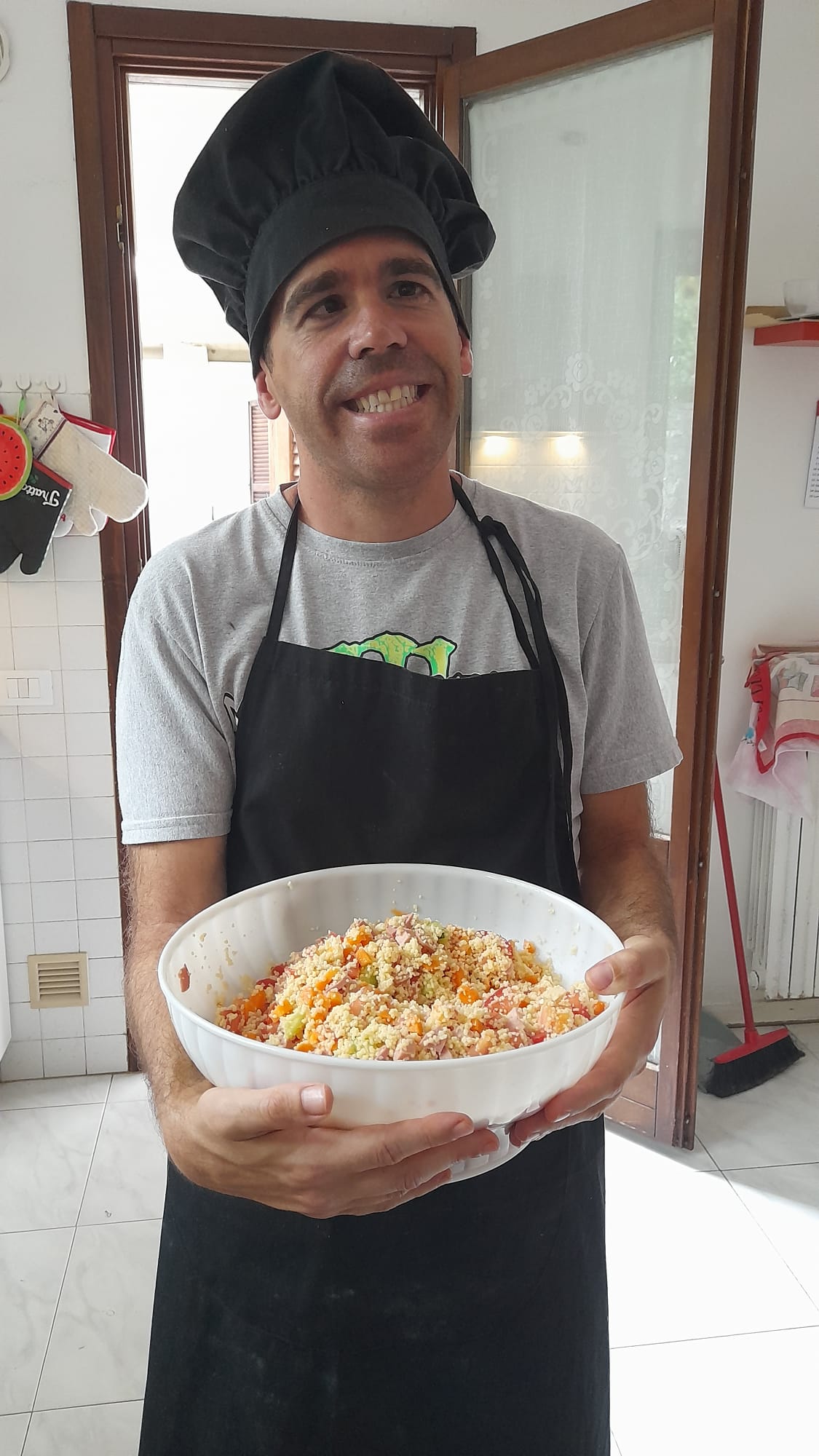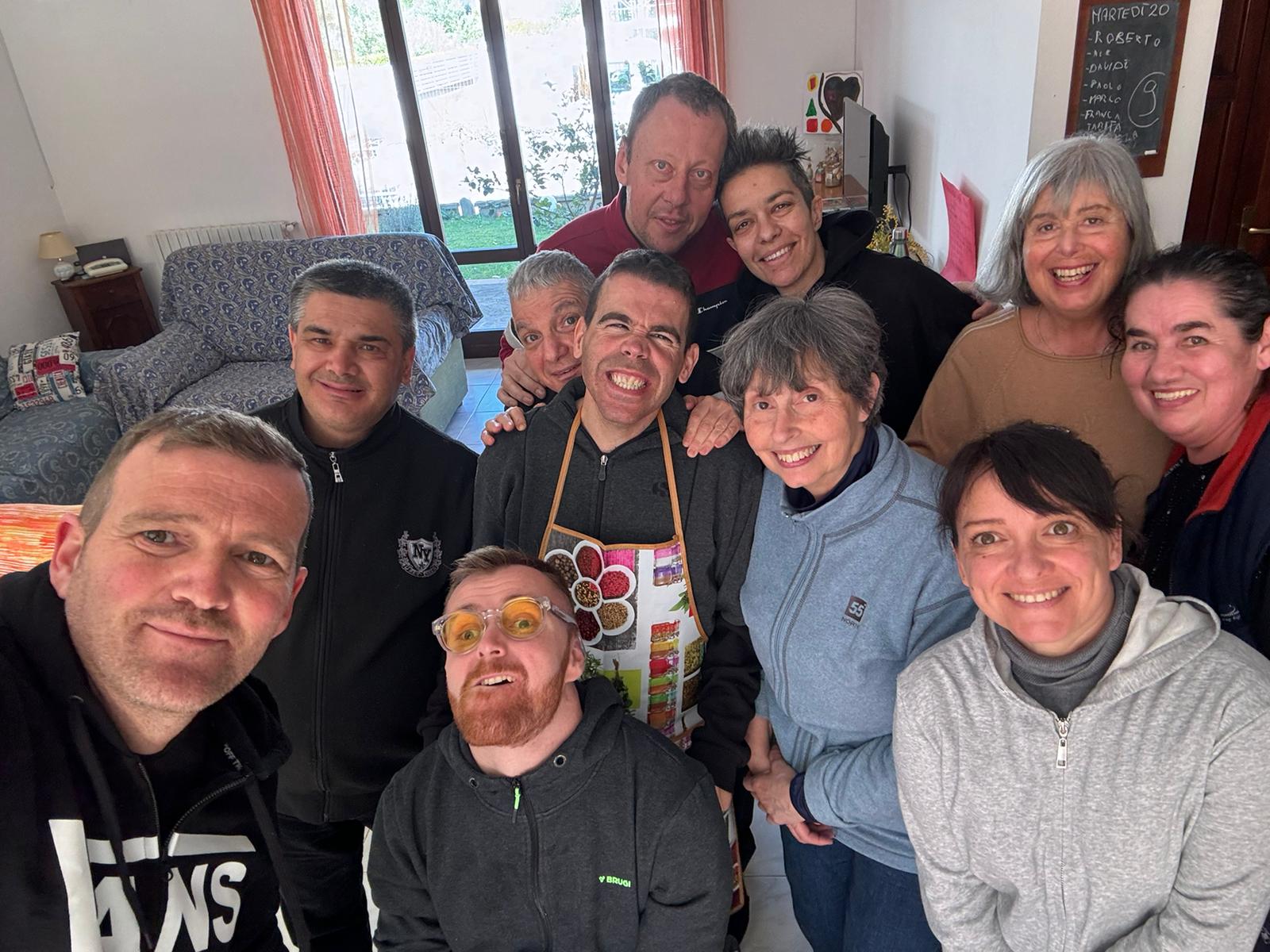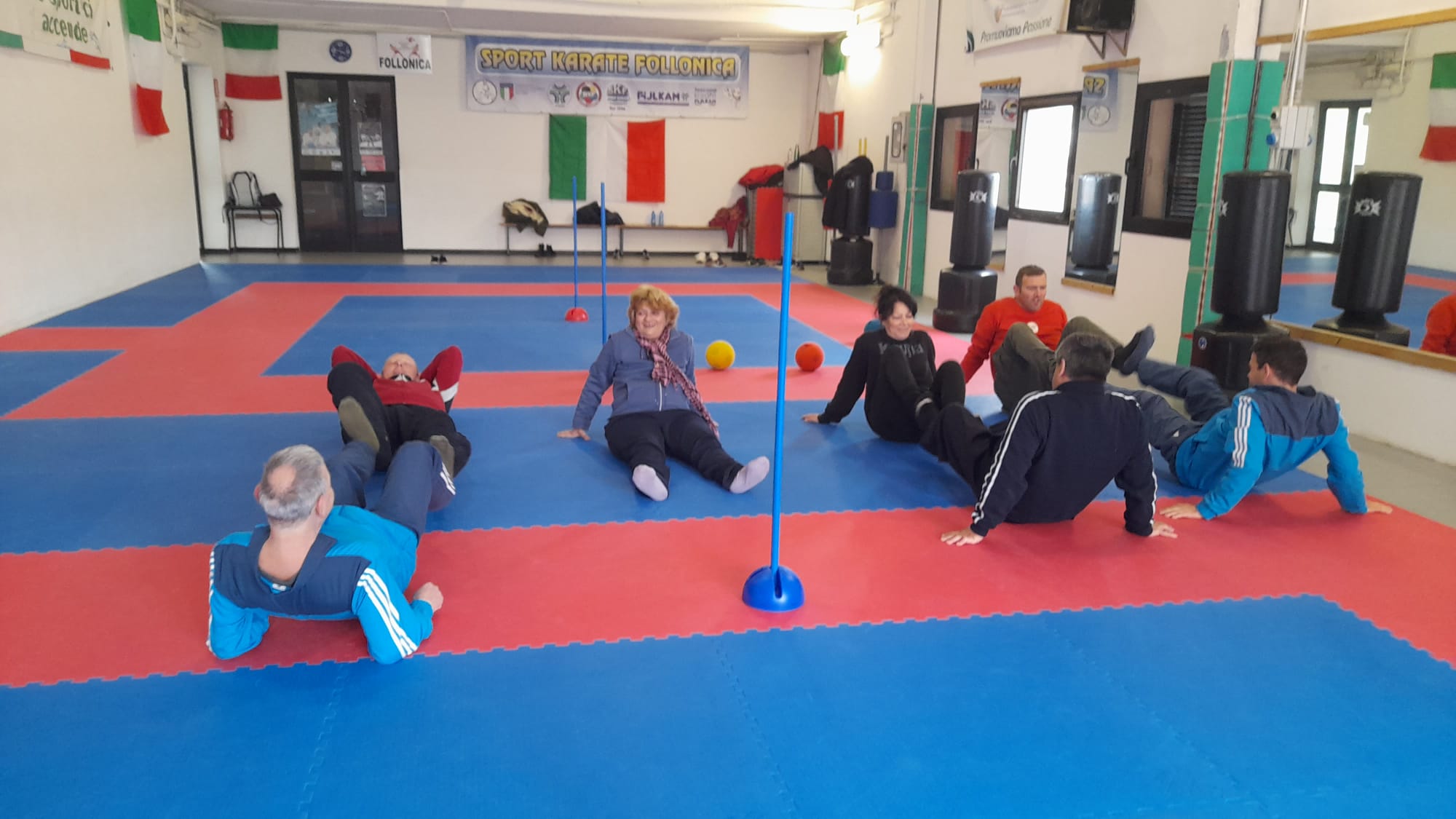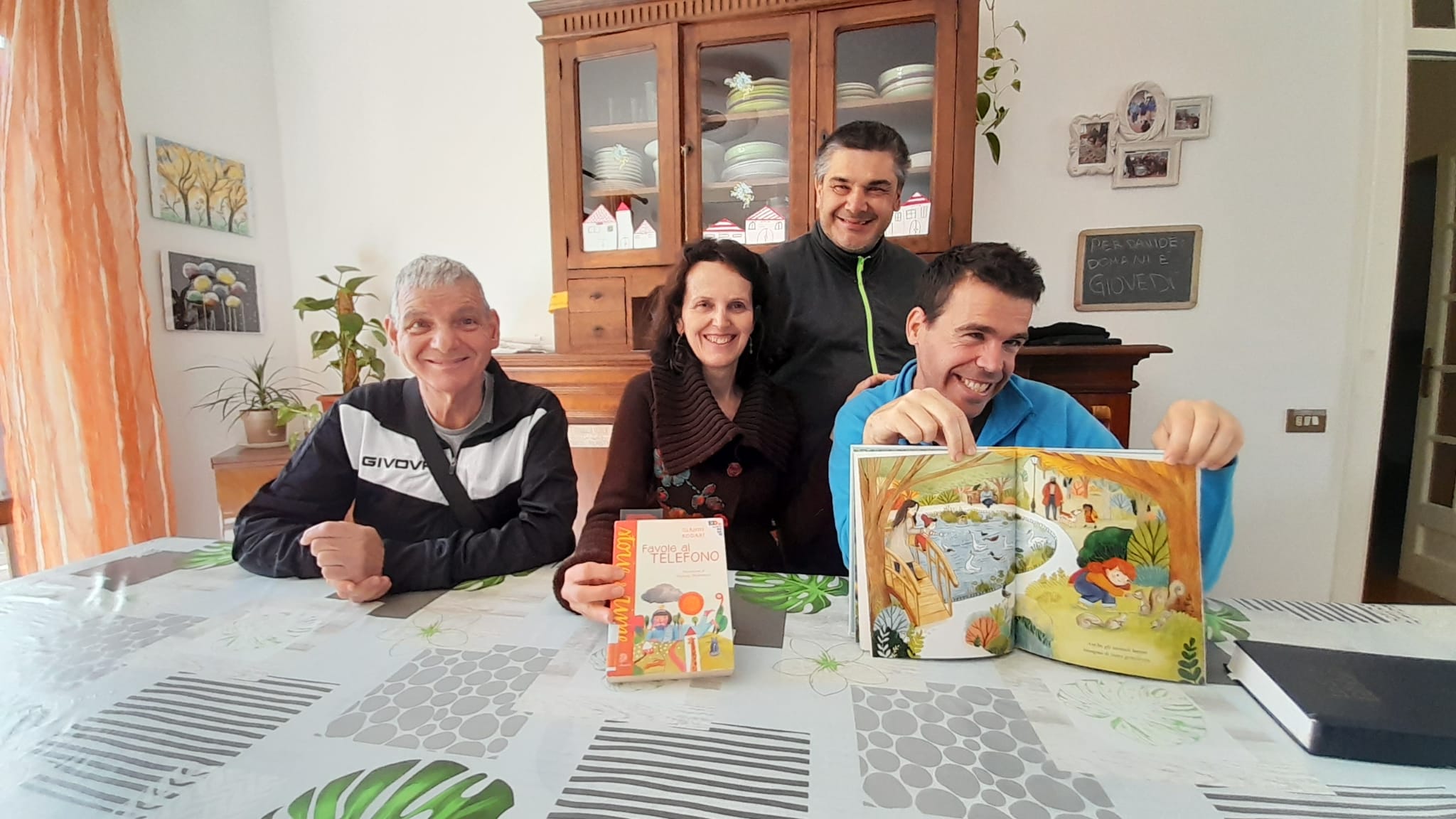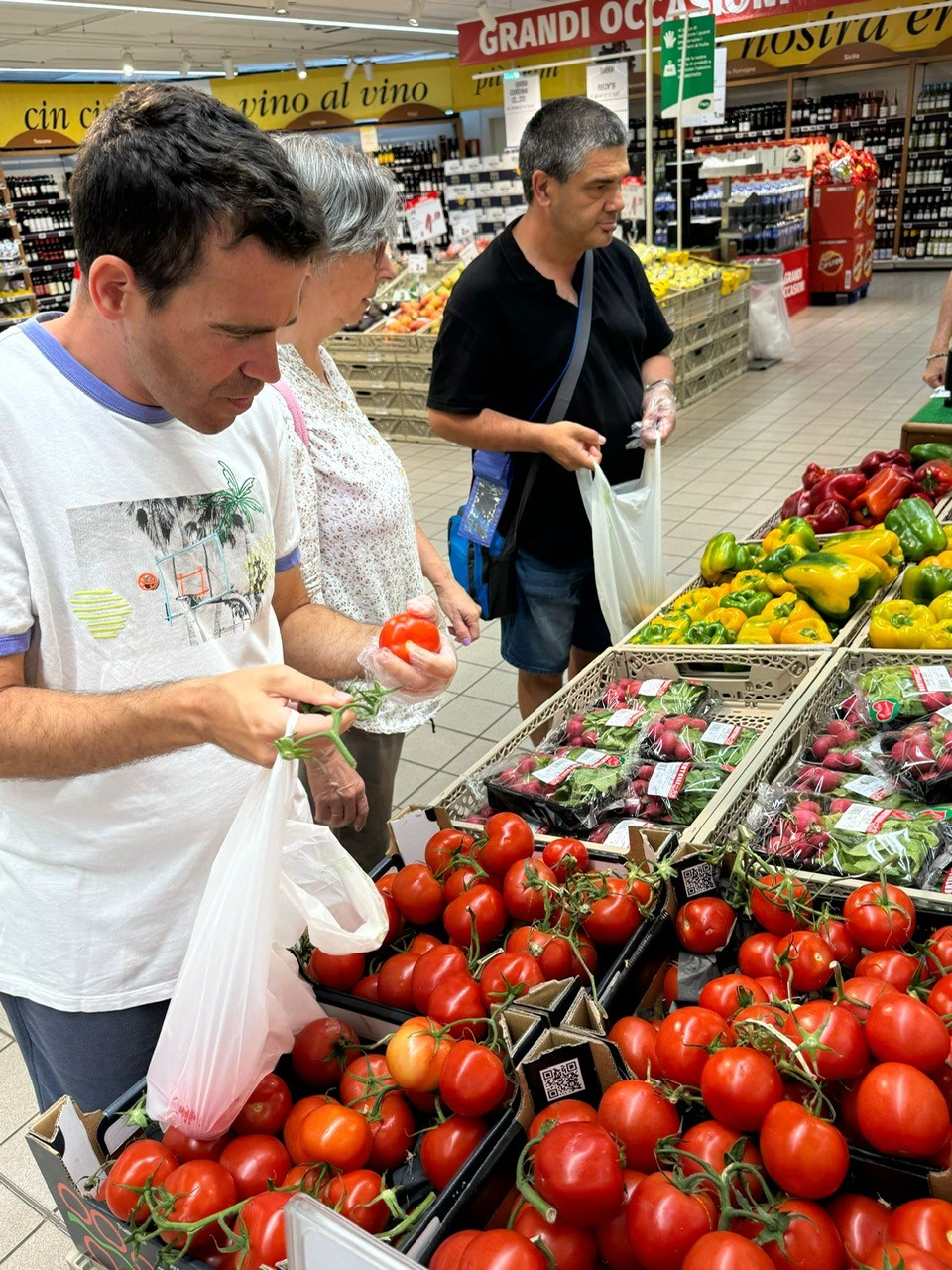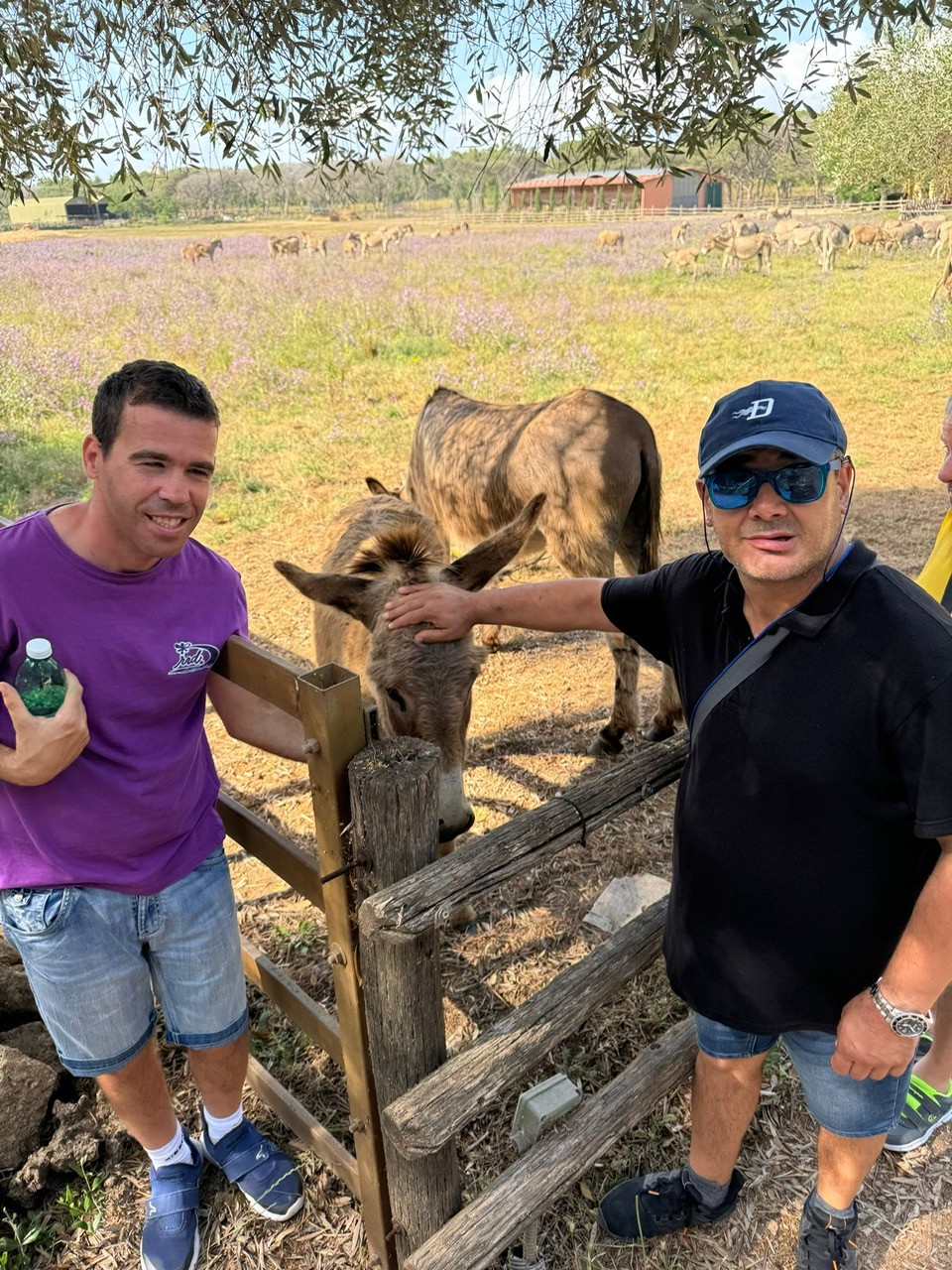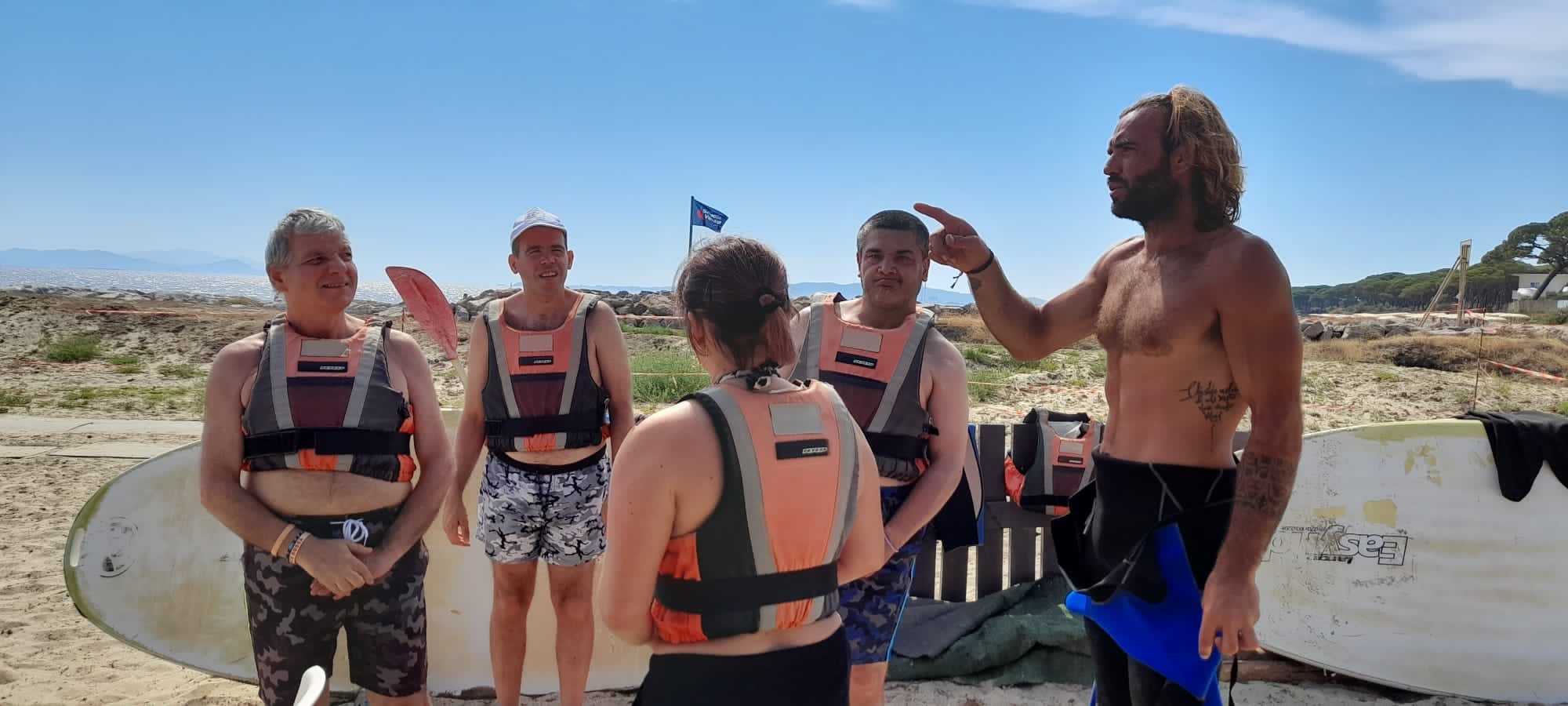Prioritising the places and people that need it the most
Gifted Nature - Living and Experiencing
Inclusive Living and Environmental Education for Community Empowerment
"Gifted Nature - Living and Experiencing Inclusive Beauty " is an innovative project that combines co-housing for people with disabilities and environmental education. By fostering autonomy, creativity, and community integration, participants engage in hands-on workshops, nature excursions, and cultural events. The project celebrates inclusivity, sustainability, and the transformative power of shared experiences to inspire a more equitable and connected society
Italy
Local
Follonica (Gr) 58022 Italy
Mainly urban
It refers to other types of transformations (soft investment)
Yes
2024-12-31
No
No
Yes
Yes
Yes
As a representative of an organisation
Innovative project designed to integrate inclusive co-housing with environmental education for individuals with disabilities, families, and vulnerable communities. Building on the foundation of the long-standing "Casina Mia" initiative, the project promotes autonomy, social inclusion, and sustainability by offering shared experiences in natural and urban settings.
Overall Aim: To create a replicable model of inclusive living and environmental education that empowers participants by fostering independence, building community connections, and promoting sustainable lifestyles.
Target Groups: The project primarily serves individuals with intellectual and physical disabilities, aged 25-55, residing in co-housing arrangements or their family homes. It also engages families, volunteers, and the wider local community.
Specific Objectives:
• Housing Skills: Teach practical skills such as cooking, cleaning, and financial management to foster independence.
• Environmental Education: Promote awareness of biodiversity and sustainability through nature excursions and workshops, including accessible sailing trips with the Italian Naval League.
• Social Inclusion: Encourage participation in local activities and create support networks by involving families, associations, and community members.
• Personal Growth: Boost self-esteem and social skills through creative workshops like music, art, and digital storytelling.
• Community Impact: Raise awareness about inclusivity and sustainability through public events, workshops, and initiatives.
Achieved Outcomes:
• Enhanced autonomy for participants, improving life management and fostering self-confidence.
• Development of a cohesive and inclusive community actively engaged in educational and recreational activities.
• Increased awareness and support in the local community for disability inclusion and sustainability.
Overall Aim: To create a replicable model of inclusive living and environmental education that empowers participants by fostering independence, building community connections, and promoting sustainable lifestyles.
Target Groups: The project primarily serves individuals with intellectual and physical disabilities, aged 25-55, residing in co-housing arrangements or their family homes. It also engages families, volunteers, and the wider local community.
Specific Objectives:
• Housing Skills: Teach practical skills such as cooking, cleaning, and financial management to foster independence.
• Environmental Education: Promote awareness of biodiversity and sustainability through nature excursions and workshops, including accessible sailing trips with the Italian Naval League.
• Social Inclusion: Encourage participation in local activities and create support networks by involving families, associations, and community members.
• Personal Growth: Boost self-esteem and social skills through creative workshops like music, art, and digital storytelling.
• Community Impact: Raise awareness about inclusivity and sustainability through public events, workshops, and initiatives.
Achieved Outcomes:
• Enhanced autonomy for participants, improving life management and fostering self-confidence.
• Development of a cohesive and inclusive community actively engaged in educational and recreational activities.
• Increased awareness and support in the local community for disability inclusion and sustainability.
Inclusivity: Promoting accessibility and active participation for individuals with disabilities in all activities.
Sustainability: Fostering environmentally friendly practices and encouraging responsible living through education and action.
Community: Building strong local networks by involving families, volunteers, and organizations in shared initiatives.
Empowerment: Enhancing personal autonomy, self-confidence, and life skills for participants through hands-on experiences.
Education: Providing creative and practical learning opportunities focused on housing, environmental awareness, and social integration.
The key objectives of "Gifted Nature - Living and Experiencing Inclusive Beauty" in terms of sustainability focus on fostering environmentally responsible behaviors, promoting resource-efficient practices, and cultivating a deeper connection with the natural environment. These objectives have been met through a combination of education, hands-on activities, and community engagement:
1. Promoting Responsible Lifestyles:
Through workshops and daily routines, participants have learned to adopt sustainable habits, including waste reduction, energy-saving practices, and the use of locally sourced, zero-kilometer products. Cooking and financial management sessions emphasize conscious consumption, resource optimization, and seasonal, eco-friendly choices.
2. Environmental Awareness and Connection:
Monthly excursions to protected natural areas in the Maremma and accessible sailing trips have educated participants about biodiversity, conservation, and sustainable ecosystems. These experiences have inspired participants to value and protect their surroundings, transforming them into advocates for environmental stewardship.
3. Eco-Friendly Practices:
The project incorporates eco-friendly materials in its workshops and activities, ensuring minimal environmental impact. Creative workshops, for instance, focus on reusing materials to create artistic products, fostering a culture of recycling and upcycling among participants.
4. Community Engagement for Sustainability:
Public events and collaborative initiatives have raised awareness of sustainability and inclusivity, creating a ripple effect within the local community. These events demonstrate how inclusive projects can promote sustainability while fostering social cohesion.
Exemplary Impact:
This project serves as a replicable model of sustainable inclusion, showcasing how education and active participation can lead to meaningful change.
1. Promoting Responsible Lifestyles:
Through workshops and daily routines, participants have learned to adopt sustainable habits, including waste reduction, energy-saving practices, and the use of locally sourced, zero-kilometer products. Cooking and financial management sessions emphasize conscious consumption, resource optimization, and seasonal, eco-friendly choices.
2. Environmental Awareness and Connection:
Monthly excursions to protected natural areas in the Maremma and accessible sailing trips have educated participants about biodiversity, conservation, and sustainable ecosystems. These experiences have inspired participants to value and protect their surroundings, transforming them into advocates for environmental stewardship.
3. Eco-Friendly Practices:
The project incorporates eco-friendly materials in its workshops and activities, ensuring minimal environmental impact. Creative workshops, for instance, focus on reusing materials to create artistic products, fostering a culture of recycling and upcycling among participants.
4. Community Engagement for Sustainability:
Public events and collaborative initiatives have raised awareness of sustainability and inclusivity, creating a ripple effect within the local community. These events demonstrate how inclusive projects can promote sustainability while fostering social cohesion.
Exemplary Impact:
This project serves as a replicable model of sustainable inclusion, showcasing how education and active participation can lead to meaningful change.
The project prioritizes aesthetics and the quality of experience by fostering beauty, cultural engagement, and well-being for individuals with disabilities and the broader community. These objectives have been achieved through inclusive design, creative expression, and meaningful connections.
1. Celebration of Natural Beauty:
Participants engage in nature excursions and accessible sailing trips, experiencing the biodiversity and scenic beauty of the Maremma region. These activities offer emotional and sensory enrichment, connecting participants with the environment.
2. Inclusive and Functional Design:
Living and workshop spaces are designed to be accessible and inviting, ensuring comfort and dignity for all participants. Universal design principles enhance functionality while promoting a sense of belonging.
3. Cultural and Artistic Engagement:
Creative workshops in music, art, and storytelling empower participants to express their individuality and connect with culture. Handcrafted works and multimedia creations are shared during community events, enriching the cultural fabric and fostering mutual appreciation.
4. Quality of Daily Life:
Activities such as cooking and collaborative projects merge functionality with cultural enrichment, creating everyday moments of beauty and achievement. Participants share meaningful tasks, enhancing their sense of purpose and joy.
Exemplary Impact:
The project demonstrates how aesthetics and cultural benefits can transform lives by integrating beauty, accessibility, and inclusivity. It provides a replicable model that shows how everyone, regardless of ability, can engage with and contribute to cultural and environmental experiences, fostering equity and inspiration across communities.
1. Celebration of Natural Beauty:
Participants engage in nature excursions and accessible sailing trips, experiencing the biodiversity and scenic beauty of the Maremma region. These activities offer emotional and sensory enrichment, connecting participants with the environment.
2. Inclusive and Functional Design:
Living and workshop spaces are designed to be accessible and inviting, ensuring comfort and dignity for all participants. Universal design principles enhance functionality while promoting a sense of belonging.
3. Cultural and Artistic Engagement:
Creative workshops in music, art, and storytelling empower participants to express their individuality and connect with culture. Handcrafted works and multimedia creations are shared during community events, enriching the cultural fabric and fostering mutual appreciation.
4. Quality of Daily Life:
Activities such as cooking and collaborative projects merge functionality with cultural enrichment, creating everyday moments of beauty and achievement. Participants share meaningful tasks, enhancing their sense of purpose and joy.
Exemplary Impact:
The project demonstrates how aesthetics and cultural benefits can transform lives by integrating beauty, accessibility, and inclusivity. It provides a replicable model that shows how everyone, regardless of ability, can engage with and contribute to cultural and environmental experiences, fostering equity and inspiration across communities.
The project champions inclusion by ensuring accessibility, affordability, and participation for individuals with disabilities, families, and the wider community. It embodies principles of equity, promoting personal growth, community integration, and sustainable living.
1. Accessibility for All
The project prioritizes universal design in co-housing and workshop facilities, ensuring all activities, such as nature excursions and sailing trips, are tailored for diverse abilities, offering equal opportunities for participation.
2. Affordability
Through public funding, donations, and volunteer support, the project minimizes financial barriers for participants. Initiatives like sourcing local materials and zero-kilometer food further reduce costs, ensuring inclusivity.
3. Inclusive Governance
Participants actively contribute to decisions in the co-housing environment, fostering autonomy and empowerment. Collaborative governance creates shared responsibility and strengthens a sense of belonging.
4. Design for All Principles
The project integrates inclusivity into every aspect, from accessible housing to creative workshops, allowing participants to express themselves while fostering collaboration and mutual respect.
5. New Societal Models
It establishes a model of inclusive living that combines housing, education, and community engagement. By connecting individuals with disabilities, families, and local communities, it promotes mutual understanding and shared growth.
Exemplary Impact
This initiative exemplifies how inclusion can drive empowerment and community integration. Its accessible, affordable, and collaborative approach serves as a replicable model for equitable living, inspiring societies to embrace diversity and build stronger, more connected communities.
1. Accessibility for All
The project prioritizes universal design in co-housing and workshop facilities, ensuring all activities, such as nature excursions and sailing trips, are tailored for diverse abilities, offering equal opportunities for participation.
2. Affordability
Through public funding, donations, and volunteer support, the project minimizes financial barriers for participants. Initiatives like sourcing local materials and zero-kilometer food further reduce costs, ensuring inclusivity.
3. Inclusive Governance
Participants actively contribute to decisions in the co-housing environment, fostering autonomy and empowerment. Collaborative governance creates shared responsibility and strengthens a sense of belonging.
4. Design for All Principles
The project integrates inclusivity into every aspect, from accessible housing to creative workshops, allowing participants to express themselves while fostering collaboration and mutual respect.
5. New Societal Models
It establishes a model of inclusive living that combines housing, education, and community engagement. By connecting individuals with disabilities, families, and local communities, it promotes mutual understanding and shared growth.
Exemplary Impact
This initiative exemplifies how inclusion can drive empowerment and community integration. Its accessible, affordable, and collaborative approach serves as a replicable model for equitable living, inspiring societies to embrace diversity and build stronger, more connected communities.
Citizens and civil society are central to the project, actively shaping its design and outcomes.
Beneficiaries as Co-creators:
Participants with disabilities contribute to decision-making, daily management, and workshop planning, fostering autonomy and empowerment.
Family and Volunteer Support:
Families collaborate to tailor activities to participants’ needs, while volunteers assist in workshops and excursions, creating a strong community support system.
Community Partnerships:
Local organizations and associations expand the project's reach. Partnerships like those with the Italian Naval League enable accessible activities, such as inclusive sailing trips.
Public Engagement:
Community events showcase participants’ achievements, encouraging interaction, reducing stigma, and fostering broader societal commitment to inclusivity.
Impact:
This involvement ensures the project addresses real needs, enriches activities, and strengthens community bonds, creating a replicable model for inclusive and collaborative living.
Beneficiaries as Co-creators:
Participants with disabilities contribute to decision-making, daily management, and workshop planning, fostering autonomy and empowerment.
Family and Volunteer Support:
Families collaborate to tailor activities to participants’ needs, while volunteers assist in workshops and excursions, creating a strong community support system.
Community Partnerships:
Local organizations and associations expand the project's reach. Partnerships like those with the Italian Naval League enable accessible activities, such as inclusive sailing trips.
Public Engagement:
Community events showcase participants’ achievements, encouraging interaction, reducing stigma, and fostering broader societal commitment to inclusivity.
Impact:
This involvement ensures the project addresses real needs, enriches activities, and strengthens community bonds, creating a replicable model for inclusive and collaborative living.
Local Level
At the core, families of participants played an essential role, actively collaborating in the development of tailored activities. Local volunteers, including educators and skilled professionals, supported daily operations, workshops, and special events, fostering a strong connection with the community. Partnerships with local institutions, such as libraries and sports organizations, further enriched the program by providing access to resources and venues.
Regional Level
Regional stakeholders, including COeSO Società della Salute, offered strategic guidance and funding, ensuring the project addressed regional social needs. Collaboration with similar initiatives in the area created opportunities for knowledge exchange and joint events, fostering an inclusive network of support.
National Level
National organizations contributed funding and expertise to expand the project’s reach and impact. Partnerships with institutions like the Italian Naval League introduced innovative components, such as accessible sailing activities, that enhanced both the inclusivity and uniqueness of the program.
European Level
The project aligns with European priorities, such as promoting social inclusion, sustainability, and accessibility. Although its implementation is local, it offers a model that can be adapted across EU regions, contributing to shared goals of equity and community cohesion.
Added Value of Stakeholder Engagement
The multi-level collaboration ensured the project’s sustainability and scalability. Local engagement brought relevance and community trust. Regional and national partnerships introduced resources, knowledge, and innovation, strengthening the project's impact. At the European level, the alignment with broader values positioned the initiative as a replicable model for inclusive and sustainable development, capable of inspiring similar efforts across the EU.
At the core, families of participants played an essential role, actively collaborating in the development of tailored activities. Local volunteers, including educators and skilled professionals, supported daily operations, workshops, and special events, fostering a strong connection with the community. Partnerships with local institutions, such as libraries and sports organizations, further enriched the program by providing access to resources and venues.
Regional Level
Regional stakeholders, including COeSO Società della Salute, offered strategic guidance and funding, ensuring the project addressed regional social needs. Collaboration with similar initiatives in the area created opportunities for knowledge exchange and joint events, fostering an inclusive network of support.
National Level
National organizations contributed funding and expertise to expand the project’s reach and impact. Partnerships with institutions like the Italian Naval League introduced innovative components, such as accessible sailing activities, that enhanced both the inclusivity and uniqueness of the program.
European Level
The project aligns with European priorities, such as promoting social inclusion, sustainability, and accessibility. Although its implementation is local, it offers a model that can be adapted across EU regions, contributing to shared goals of equity and community cohesion.
Added Value of Stakeholder Engagement
The multi-level collaboration ensured the project’s sustainability and scalability. Local engagement brought relevance and community trust. Regional and national partnerships introduced resources, knowledge, and innovation, strengthening the project's impact. At the European level, the alignment with broader values positioned the initiative as a replicable model for inclusive and sustainable development, capable of inspiring similar efforts across the EU.
The project reflects a multidisciplinary approach, integrating expertise from social sciences, environmental studies, urban design, education, and creative arts. This foundation enabled activities that promote autonomy, inclusivity, and sustainability.
Disciplines and Knowledge Fields
Social Sciences and Psychology: Social workers and psychologists developed personalized plans to address participants' unique needs, fostering autonomy and inclusion.
Environmental Studies: Educators led workshops and excursions, promoting sustainability awareness and biodiversity conservation.
Urban Design and Accessibility: Specialists ensured inclusive living spaces, adapted to individuals with disabilities.
Education and Training: Practical workshops on daily skills reinforced life autonomy.
Creative Arts: Artists and musicians led workshops fostering self-expression, emotional well-being, and community connection.
Interdisciplinary Interaction
Collaboration among these disciplines was key. Psychologists worked with educators and environmental specialists to tailor activities to participants' needs. Urban designers ensured spaces facilitated independence. Artists and environmental educators designed creative projects that integrated expression with ecological themes.
Added Value
This interdisciplinary collaboration addressed participants' functional, emotional, cognitive, and social growth. By blending diverse perspectives, the project became a replicable model of inclusion and sustainability, showcasing the transformative power of multidisciplinary approaches.
Disciplines and Knowledge Fields
Social Sciences and Psychology: Social workers and psychologists developed personalized plans to address participants' unique needs, fostering autonomy and inclusion.
Environmental Studies: Educators led workshops and excursions, promoting sustainability awareness and biodiversity conservation.
Urban Design and Accessibility: Specialists ensured inclusive living spaces, adapted to individuals with disabilities.
Education and Training: Practical workshops on daily skills reinforced life autonomy.
Creative Arts: Artists and musicians led workshops fostering self-expression, emotional well-being, and community connection.
Interdisciplinary Interaction
Collaboration among these disciplines was key. Psychologists worked with educators and environmental specialists to tailor activities to participants' needs. Urban designers ensured spaces facilitated independence. Artists and environmental educators designed creative projects that integrated expression with ecological themes.
Added Value
This interdisciplinary collaboration addressed participants' functional, emotional, cognitive, and social growth. By blending diverse perspectives, the project became a replicable model of inclusion and sustainability, showcasing the transformative power of multidisciplinary approaches.
The project is innovative for its holistic approach, integrating co-housing for individuals with disabilities and environmental education, surpassing conventional practices. It merges autonomy-building, sustainability, and inclusivity into a replicable model that empowers individuals and strengthens community ties.
Key Innovations
Co-housing Model: Provides full-time community living, fostering independence while addressing the "Dopo di Noi" (Life After Us) initiative.
Environmental Integration: Accessible nature excursions and sailing trips promote sustainability awareness and inclusivity, merging education with practical experiences.
Creative Empowerment: Arts, music, and storytelling workshops enhance self-expression, self-esteem, and community connection.
Collaborative Network: Families, authorities, educators, and volunteers create a dynamic, sustainable support network.
Inclusive Design: Universally accessible spaces promote independence and full participation.
Comparison to Mainstream Actions
Unlike conventional projects focusing on housing or skills, this initiative combines life skills, environmental education, and cultural participation, addressing participants' physical, emotional, and social needs holistically.
Exemplary Value
This comprehensive approach enhances lives and offers a replicable framework for inclusive, sustainable living, setting a benchmark for transformative community-building practices.
Key Innovations
Co-housing Model: Provides full-time community living, fostering independence while addressing the "Dopo di Noi" (Life After Us) initiative.
Environmental Integration: Accessible nature excursions and sailing trips promote sustainability awareness and inclusivity, merging education with practical experiences.
Creative Empowerment: Arts, music, and storytelling workshops enhance self-expression, self-esteem, and community connection.
Collaborative Network: Families, authorities, educators, and volunteers create a dynamic, sustainable support network.
Inclusive Design: Universally accessible spaces promote independence and full participation.
Comparison to Mainstream Actions
Unlike conventional projects focusing on housing or skills, this initiative combines life skills, environmental education, and cultural participation, addressing participants' physical, emotional, and social needs holistically.
Exemplary Value
This comprehensive approach enhances lives and offers a replicable framework for inclusive, sustainable living, setting a benchmark for transformative community-building practices.
The project employs a holistic, person-centered methodology integrating co-housing, environmental education, and community engagement to promote autonomy, inclusivity, and sustainability. It emphasizes practical interventions and participatory activities to empower individuals and build cohesive communities.
Core Methodology
Person-Centered Approach: Tailored activities address individual needs and aspirations, fostering personal growth and autonomy.
Co-Housing Model: Participants share supportive living spaces, learning essential skills like cooking, cleaning, and financial management while fostering mutual support.
Experiential Learning: Workshops and activities focus on hands-on engagement, such as nature excursions, gardening, and sailing, promoting sustainability and ecological awareness.
Community Integration: Collaboration with families, local organizations, and volunteers ensures strong ties to cultural and community life.
Inclusive Design Principles: All spaces and activities are designed for universal accessibility, allowing full participation regardless of ability.
Implementation Process
Assessment: Individual needs and strengths guide activity customization.
Structured Activities: Life skills training, environmental education, and creative workshops form a core part of daily routines.
Evaluation: Ongoing monitoring and feedback ensure adaptability and success.
Outcomes
This innovative, inclusive, and adaptable approach demonstrates how co-housing and community engagement can empower individuals while fostering sustainability and a sense of belonging.
Core Methodology
Person-Centered Approach: Tailored activities address individual needs and aspirations, fostering personal growth and autonomy.
Co-Housing Model: Participants share supportive living spaces, learning essential skills like cooking, cleaning, and financial management while fostering mutual support.
Experiential Learning: Workshops and activities focus on hands-on engagement, such as nature excursions, gardening, and sailing, promoting sustainability and ecological awareness.
Community Integration: Collaboration with families, local organizations, and volunteers ensures strong ties to cultural and community life.
Inclusive Design Principles: All spaces and activities are designed for universal accessibility, allowing full participation regardless of ability.
Implementation Process
Assessment: Individual needs and strengths guide activity customization.
Structured Activities: Life skills training, environmental education, and creative workshops form a core part of daily routines.
Evaluation: Ongoing monitoring and feedback ensure adaptability and success.
Outcomes
This innovative, inclusive, and adaptable approach demonstrates how co-housing and community engagement can empower individuals while fostering sustainability and a sense of belonging.
1. Methodology and Approach
The person-centered methodology integrating co-housing, environmental education, and community engagement offers a flexible model adaptable to various contexts. By addressing individual needs and promoting inclusivity, this approach can benefit diverse groups, including people with disabilities and underprivileged communities.
2. Co-Housing Model
The inclusive housing framework fosters independence, mutual support, and community integration. It provides a scalable solution for social inclusion and housing challenges, suitable for replication in different locations.
3. Workshops and Activities
Life skills workshops, creative activities, and environmental education can be easily adapted to local resources and cultural contexts. Examples include gardening, sustainable cooking, and outdoor activities, which can be customized for specific needs.
4. Community Partnerships
Engaging families, volunteers, and local associations ensures sustainability and local ownership. This collaborative strategy is a transferable model for building strong networks that support beneficiaries and projects alike.
5. Tools and Processes
Using accessible spaces, participatory decision-making, and inclusive design principles promotes equality and active participation. These elements can guide other initiatives in creating supportive environments.
6. Learnings and Best Practices
Insights gained from the project, such as tailoring activities to participant strengths and fostering community relationships, can inform similar initiatives. Sharing experiences can inspire others to adopt or adapt these practices.
Transferability in Action
This model’s flexibility and focus on accessibility make it applicable to various settings and demographics. It combines empowerment, community building, and sustainability, offering a replicable blueprint for fostering inclusion and resilience across diverse contexts.
The person-centered methodology integrating co-housing, environmental education, and community engagement offers a flexible model adaptable to various contexts. By addressing individual needs and promoting inclusivity, this approach can benefit diverse groups, including people with disabilities and underprivileged communities.
2. Co-Housing Model
The inclusive housing framework fosters independence, mutual support, and community integration. It provides a scalable solution for social inclusion and housing challenges, suitable for replication in different locations.
3. Workshops and Activities
Life skills workshops, creative activities, and environmental education can be easily adapted to local resources and cultural contexts. Examples include gardening, sustainable cooking, and outdoor activities, which can be customized for specific needs.
4. Community Partnerships
Engaging families, volunteers, and local associations ensures sustainability and local ownership. This collaborative strategy is a transferable model for building strong networks that support beneficiaries and projects alike.
5. Tools and Processes
Using accessible spaces, participatory decision-making, and inclusive design principles promotes equality and active participation. These elements can guide other initiatives in creating supportive environments.
6. Learnings and Best Practices
Insights gained from the project, such as tailoring activities to participant strengths and fostering community relationships, can inform similar initiatives. Sharing experiences can inspire others to adopt or adapt these practices.
Transferability in Action
This model’s flexibility and focus on accessibility make it applicable to various settings and demographics. It combines empowerment, community building, and sustainability, offering a replicable blueprint for fostering inclusion and resilience across diverse contexts.
The project tackles key global challenges with locally tailored solutions:
1. Social Inclusion and Inequality
Challenge: Marginalization of individuals with disabilities and vulnerable groups.
Solution: Promoting inclusion through co-housing and collaborative activities empowers participants and integrates marginalized groups into the community.
2. Environmental Sustainability
Challenge: Resource degradation and low environmental awareness.
Solution: Environmental education and sustainable practices, like gardening and recycling, foster eco-conscious behavior and biodiversity conservation.
3. Affordable and Accessible Housing
Challenge: Lack of inclusive and affordable housing.
Solution: The co-housing model offers a replicable framework for affordable, accessible living tailored to diverse needs.
4. Health and Well-Being
Challenge: Limited access to holistic health solutions.
Solution: Life skills workshops, creative sessions, and fitness programs enhance mental, emotional, and physical well-being.
5. Community Resilience and Empowerment
Challenge: Weak local support networks.
Solution: Engaging families, volunteers, and local organizations strengthens community ties and fosters resilience.
Scalable Impact
By addressing these challenges locally, the project demonstrates a replicable model for inclusive, resilient, and sustainable communities worldwide.
1. Social Inclusion and Inequality
Challenge: Marginalization of individuals with disabilities and vulnerable groups.
Solution: Promoting inclusion through co-housing and collaborative activities empowers participants and integrates marginalized groups into the community.
2. Environmental Sustainability
Challenge: Resource degradation and low environmental awareness.
Solution: Environmental education and sustainable practices, like gardening and recycling, foster eco-conscious behavior and biodiversity conservation.
3. Affordable and Accessible Housing
Challenge: Lack of inclusive and affordable housing.
Solution: The co-housing model offers a replicable framework for affordable, accessible living tailored to diverse needs.
4. Health and Well-Being
Challenge: Limited access to holistic health solutions.
Solution: Life skills workshops, creative sessions, and fitness programs enhance mental, emotional, and physical well-being.
5. Community Resilience and Empowerment
Challenge: Weak local support networks.
Solution: Engaging families, volunteers, and local organizations strengthens community ties and fosters resilience.
Scalable Impact
By addressing these challenges locally, the project demonstrates a replicable model for inclusive, resilient, and sustainable communities worldwide.
Direct Benefits for Participants:
Increased Autonomy: Participants have developed practical skills like cooking, cleaning, and financial management, enhancing their self-sufficiency.
Enhanced Well-being: Creative workshops, fitness programs, and therapeutic activities have improved emotional, mental, and physical health.
Stronger Social Skills: Collaborative activities and events have fostered teamwork, empathy, and conflict resolution.
Economic Empowerment: Protected work placements have provided opportunities for financial independence and professional growth.
Community-Level Outcomes:
Social Inclusion: Participants are actively involved in local events, breaking stigmas and promoting acceptance.
Strengthened Networks: Collaboration with families, local organizations, and volunteers has built a supportive ecosystem.
Cultural Awareness: Public events and artistic contributions by participants have enriched the community and raised awareness about inclusion.
Environmental Impacts:
Sustainability Practices: Gardening, recycling, and eco-friendly initiatives have promoted environmental stewardship.
Awareness of Biodiversity: Nature excursions and workshops have fostered appreciation for biodiversity and sustainable behaviors.
Wider Impacts on Society:
Replication Potential: The project offers a scalable model for inclusive living and sustainability in other communities.
Policy Influence: Its success has drawn interest from policymakers and organizations aiming to replicate its innovative approaches.
Indirect Beneficiaries: Families of participants benefit from reduced caregiving burdens and enhanced social connections.
Overall Impact:
The project has created a transformative environment where individuals with disabilities and vulnerable groups thrive, while fostering community values of inclusivity, sustainability, and resilience.
Increased Autonomy: Participants have developed practical skills like cooking, cleaning, and financial management, enhancing their self-sufficiency.
Enhanced Well-being: Creative workshops, fitness programs, and therapeutic activities have improved emotional, mental, and physical health.
Stronger Social Skills: Collaborative activities and events have fostered teamwork, empathy, and conflict resolution.
Economic Empowerment: Protected work placements have provided opportunities for financial independence and professional growth.
Community-Level Outcomes:
Social Inclusion: Participants are actively involved in local events, breaking stigmas and promoting acceptance.
Strengthened Networks: Collaboration with families, local organizations, and volunteers has built a supportive ecosystem.
Cultural Awareness: Public events and artistic contributions by participants have enriched the community and raised awareness about inclusion.
Environmental Impacts:
Sustainability Practices: Gardening, recycling, and eco-friendly initiatives have promoted environmental stewardship.
Awareness of Biodiversity: Nature excursions and workshops have fostered appreciation for biodiversity and sustainable behaviors.
Wider Impacts on Society:
Replication Potential: The project offers a scalable model for inclusive living and sustainability in other communities.
Policy Influence: Its success has drawn interest from policymakers and organizations aiming to replicate its innovative approaches.
Indirect Beneficiaries: Families of participants benefit from reduced caregiving burdens and enhanced social connections.
Overall Impact:
The project has created a transformative environment where individuals with disabilities and vulnerable groups thrive, while fostering community values of inclusivity, sustainability, and resilience.

